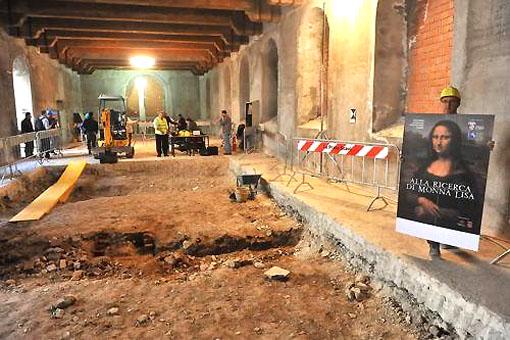The burial place of Leonardo's Mona Lisa has been located in her home town, Florence.
Leonardo scholar Giuseppe Pallanti says documents show she was interred in the city's former Convent of St Orsula, in the heart of the city.
Despite its central location, the ex-seat of the Ursuline is now an extremely run-down, almost delapidated building.
"I'm sure her tomb is in there," Pallanti said Thursday, presenting his discovery.
"I've pored through thousands of archive pages and I'm convinced the remains of Leonardo's model Lisa Gherardini was buried there".
Pallanti said his research had wiped away all doubt about the identity of La Gioconda, as the Italians call the Mona Lisa because of the surname of her husband, Giocondo.
"It was her, Lisa, the wife of the merchant Francesco Del Giocondo - and she lived right opposite Leonardo in Via Ghibellina," Pallanti said.
Most modern scholars have agreed with Pallante that the Mona Lisa sitter was Lisa del Giocondo.
The couple were married in 1495 when the bride was 16 and the groom 35.
It has frequently been suggested that del Giocondo commissioned Leonardo to paint his Mona Lisa (mona is the standard Italian contraction for madonna, or "my lady,") to mark his wife's pregnancy or the recent birth of their second child in December 1502.
Although pregnancy or childbirth have frequently been put forward in the past as explanations for Mona Lisa's cryptic smile, other theories have not been lacking - some less plausible than others.
Some have argued that the painting is a self-protrait of the artist, or one of his favourite male lovers in disguise, citing the fact that Da Vinci never actually relinquished the painting and kept it with him up until his death in Amboise, France in 1519.
The most curious theories have been provided by medical experts-cum-art lovers.
One group of medical researchers has maintained that the sitter's mouth is so firmly shut because she was undergoing mercury treatment for syphilis which turned her teeth black.
An American dentist has claimed that the tight-lipped expression was typical of people who have lost their front teeth, while a Danish doctor was convinced she suffered from congenital palsy which affected the left side of her face and this is why her hands are overly large.
A French surgeon has also put forth his view that she was semi-paralysed, perhaps as the result of a stroke, and that this explained why one hand looks relaxed and the other tense.
Leading American feminist Camille Paglia simply concluded that the cool, appraising smile showed that "what Mona Lisa is ultimately saying is that males are unnecessary".





